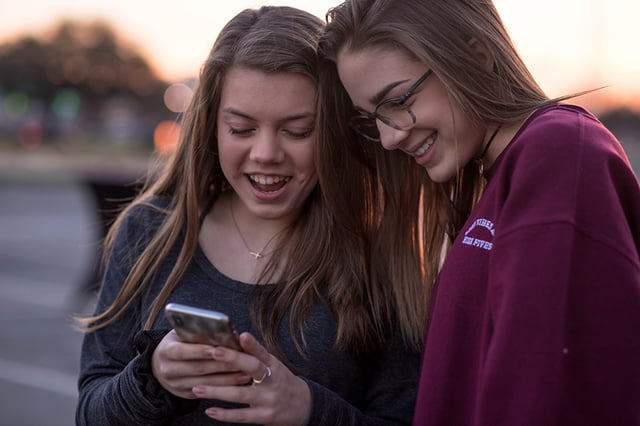The Future of Learning is Active, A Conversation with a District’s CTO
 Insights By Rich Boettner
Insights By Rich Boettner
The first time I understood technology to be a creative medium was in my tenth-grade digital photography class.
I grew up on the cusp of digital nativism – I have small recollections of dial-up internet, floppy disks, and VHS tapes. By the time I entered kindergarten, technology was becoming a fixture in learning, and it was something I started using in elementary school.
In my early experiences with it, technology was mostly used as a substitute for non-digital activities with assignments for typing practice, looking up books in the school library, and working with Word or PowerPoint. Toward the end of middle school, I started embracing technology as a way to supplement my research, connect with friends online (RIP AIM), and read the occasional news article too. I was mostly just a consumer of technology, seeing it as a means to an end.
This was until Spring semester in my high school’s digital photography class that I began to see technology as a creative medium. I was equally as fascinated and stumped by Photoshop, and as someone lacking any artistic ability, this was the first time in my life I felt empowered to create and excited to hang my work on the halls of my high school. So, if I had to choose, it was in that class where the value of technology clicked for me.
Fast forward many years, and here I am on the phone with the CTO, Rich Boettner, at Hilliard City Schools. Boettner got his start in technology while teaching music in 1991, when he wrote and received a technology grant to acquire four computers with musical keyboards so that students in his class could write music and have it play back to them.
“When you're in early elementary school you might be able to dream up a song, but you can't play it because you haven't learned how to play an instrument yet. This allows students to create and to write new songs and then be able to hear what their songs sounded like, to hear the technology.”
As Boettner transitioned into a technology coach and eventually joined Hilliard’s technology department in 1999, he became a member of a team that also shared the vision of technology “to get kids creating, writing, building, and dreaming.”
The Future of Learning is Active
This vision continues even to today. One of the questions, I asked him was, “If you could design a future of technology in schools, what would it looks like?” To Boettner, the future of technology in education is to redefine how students learn.
“I think the most powerful thing that we can do is to get students active in their learning as much as possible. The more we can use technology and learning activities that get them out of their seat and doing, designing, and actively building, that's the world that I see as the most powerful education we can build.
We've got a long way to go. No matter where you are, there's a lot of pressure for students to perform well on certain sit-down tests. That puts a lot of pressure at times on teachers to prepare students and make sure they can answer the right questions, and that can hold this back.
It's a good thing sometimes, but it also holds us back from really getting out of the traditional box of the way we learn and getting kids active, owning their learning, and really believing that "I am studying things that matter to me so that I am successful in the future.”
Classroom and Instructional Design for Active Learning
But how would a classroom that does this take shape, and what would learning look like? In my conversation with Boettner, he referenced Hilliard’s vision for a blended learning environment.
This vision for blended learning encompasses an instructional design approach to cultivate personalized and student-driven learning environments by balancing digital and face-to-face instruction. In the district’s vision, there are seven characteristics that include:
- Community Mindset
- Learning Environment
- Instruction
- Student Work
- Assessment
- Communication
- Collaboration
Two of these characteristics especially focus on active and creative learning with technology: Community Mindset and Student Work.
Community Mindset: “Teachers and students are empowered and inspired to teach and learn from one another. Learning is a partnership and a shared experience in a student-centered classroom.”
Student Work: “Students will take ownership and demonstrate understanding through authentic and relevant ways. Students will have a voice and choice in how they demonstrate their learning.”
As exemplified by these, learning at Hilliard is an active, student-led journey built on a partnership between students, teachers, and parents. By enabling students to pursue inquiry and leverage their personal interests, learning becomes far more relevant to them.
As a one-to-one district, digital tools underscore this active and student-led learning. Students use technology as a launchpad for their work that opens possibilities beyond the walls of their classroom and in ways that didn’t even exist a few years ago. To achieve the blended learning vision, students demonstrate their knowledge, create, and collaborate using these tools.
Advancing Technologies and Early Exposure
This theme of active learning with technology was also captured in our discussion of some of the new technology programs they are implementing. Boettner offered insight into how they are putting emerging technology into the hands of younger students to start engaging them in hands-on practice from an early age and help mitigate the underrepresentation of minority groups and women in computer science fields.
“One area we continue to work on and develop is coding and robotics. Business is telling us they don't have enough people who know how to code and how to get in technology systems. So, we are doing some things to help encourage more students to get excited and involved in that.
Part of the challenge that we have seen is that it's largely a very masculine-oriented field, and we have a lot of young women who are not choosing [those fields], even though they are just as highly qualified and highly capable. We also have other underrepresented groups that are not choosing that. So, we are starting robotics activities as early as kindergarten to break stereotypes with kids prior to them developing those stereotypes.
We've been trying to put robotics in the hands of our [elementary students] through hands-on learning: they code something, and then they see what the robot does, and that shows them whether they got it right or not. And it gives them something exciting to do in a hands-on way because coding can be kind of abstract.”
By introducing active learning opportunities with technology integration early in schools, Hilliard is engaging students with these tools – to change their perception of technology and their perception of themselves from users of it to creators with it.
Creating the Aha Technology Moment for Students
This got me thinking about how we create those aha moments that change students' understanding of technology. Technology is such a versatile tool, and the possibilities are endless. I thought about this when speaking with Boettner, and I’m thinking about it now when writing this. The power of technology rests in part in its ability to transform how students learn and how they learn to live.
That photography class changed the way I thought about myself in 10th grade. Boettner’s music class with computers changed the way students thought about music and themselves as musicians. Maybe some were no longer be disheartened that they couldn’t play an instrument and motivated to persevere and try, even if playing an instrument didn’t come easily to them.
The potential is infinite. If a student struggles with handwriting, learning to type might make them realize they could be a writer. A student with a short attention span could better learn if they used technology with engaging lessons and gamification. Adaptive and personalized lessons better differentiate instruction for a student falling behind in class. A student passionate about making and designing may go into computer science if they saw it as a creative and innovative field, and equitable access to technology will increase diversity and representation in the field as well.
Technology that is delivered inclusively starting at an early age will enhance the lives of students, if we teach them to create with it, design their own learning experiences with it, and dream a future with it.






